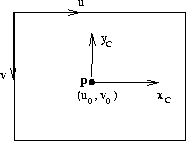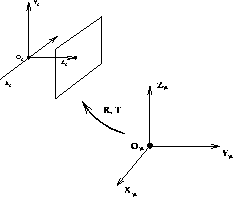轉自
http://homepages.inf.ed.ac.uk/rbf/CVonline/LOCAL_COPIES/EPSRC_SSAZ/node3.htmlThere are three coordinate systems involved --- camera, image and world.
- Camera: perspective projection.


This can be written as a linear mapping between homogeneous coordinates (the equation is only up to a scale factor):

where a
 projection matrix represents a map from 3D to 2D.
projection matrix represents a map from 3D to 2D. - Image: (intrinsic/internal camera parameters)



 is a
is a  upper triangular matrix, called the camera calibration matrix:
upper triangular matrix, called the camera calibration matrix:
where
 ,
,  .
. provides the transformation between an image point and a ray in Euclidean 3-space.
provides the transformation between an image point and a ray in Euclidean 3-space.- There are four parameters:
- The scaling in the image x and y directions,
 and
and  .
. - The principal point
 , which is the point where the optic axis intersects the image plane.
, which is the point where the optic axis intersects the image plane.
 .
. - The scaling in the image x and y directions,
- Once
 is known the camera is termed calibrated.
is known the camera is termed calibrated. - A calibrated camera is a direction sensor, able to measure the direction of rays --- like a 2D protractor.
- World: (extrinsic/external camera parameters)
The Euclidean transformation between the camera and world coordinates is :
:

Finally, concatenating the three matrices,

which defines the  projection matrix from Euclidean 3-space to an image:
projection matrix from Euclidean 3-space to an image:

沒有留言:
張貼留言